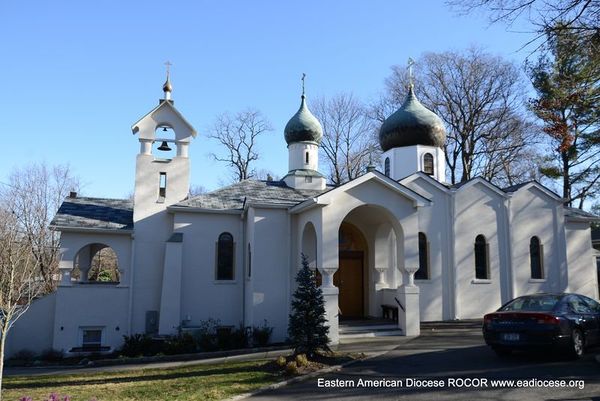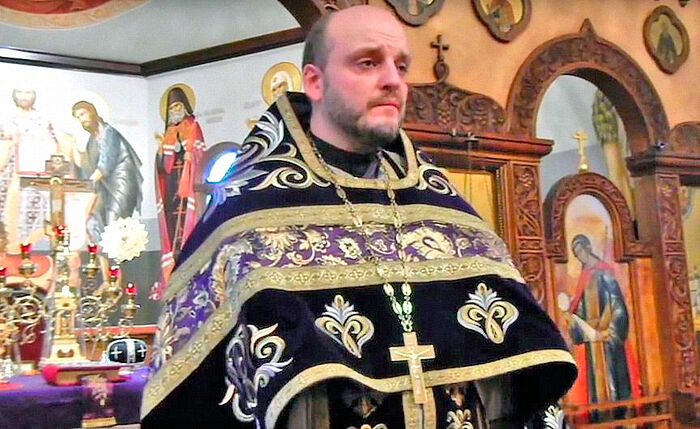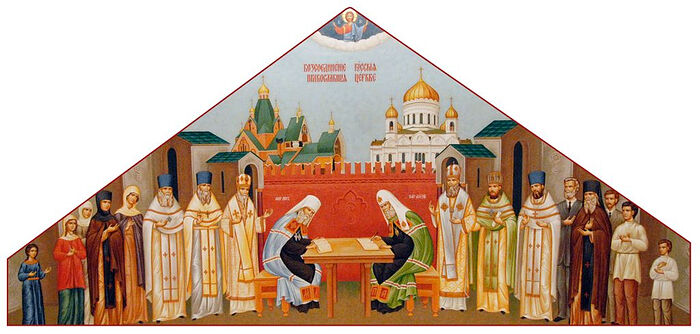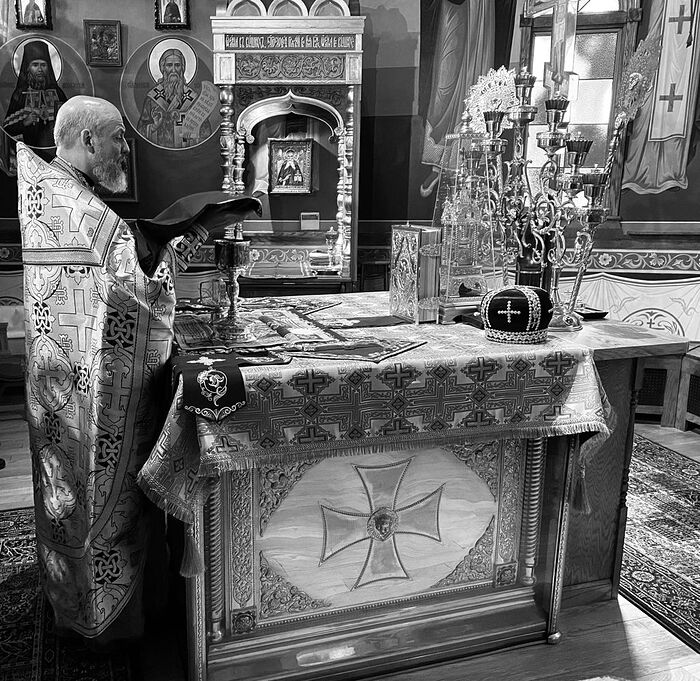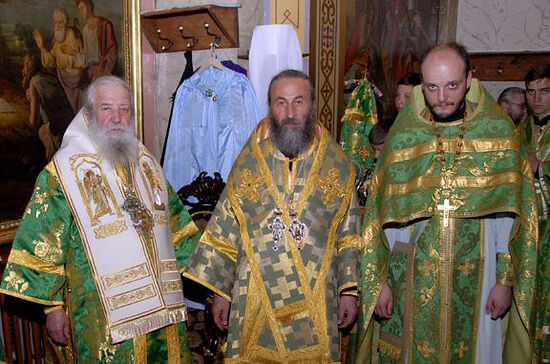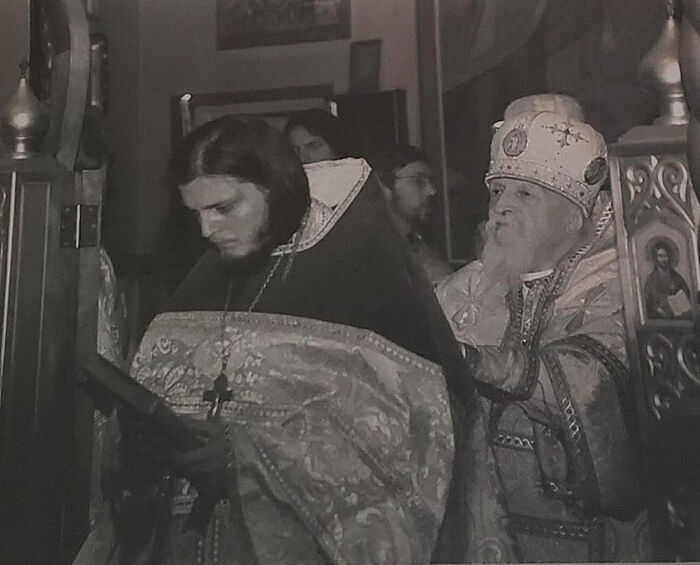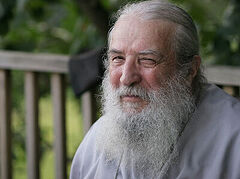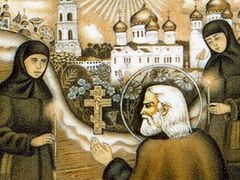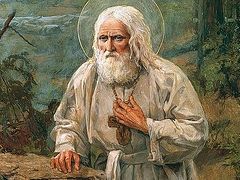Archpriest Serafim Gan is a representative of a renowned dynasty of the Russian Orthodox Church Outside of Russia, and it seems he was lucky. For 16 years now he serves in Sea Cliff, NY, at a parish bearing the name of his heavenly patron, St. Seraphim of Sarov.
St. Seraphim always helped our family
—Fr Serafim, tell us how you sense the presence of your patron saint in your own life and in the life of the parish entrusted to you.
—I think the most important events in our family always involved St. Seraphim. He always helped my family. When I was thirteen, my grandmother, Sofia Konstantinovna, told me that our ancestor, Vladyka Yuvenaly (Kilin), Archbishop of Tsitsikar, suddenly and unexpectedly participated in the translation of St. Seraphim’s relics and their washing before his canonization in 1903. At the time he was a hieromonk in Perm’s Belogorsk Monastery and accompanied its abbot, Fr Varlaam, on a pilgrimage, who, as many of the monastery’s residents, was executed in 1918. They were in Optina Hermitage and served together with St. John of Kronstadt in his city.
They had the opportunity to attend the celebrations of the glorification of St. Seraphim in Sarov. The future Vladyka Yuvenaly was asked to participate in the transfer of the relics to the cathedral. The washing and vesting of the relics took place in the altar before being moved. My grandmother’s story about how the entire church was filled with fragrance when his coffin was open moved me greatly.
My father was also named in honor of St. Seraphim, because my grandfather, Archpriest Rostislav Gan, served as rector of St. Seraphim Church in China. My father was born then and he was baptized there.
As far as concrete events in my parish, there were times when someone would get sick, or suffer some sorrow or temptation, and he would turn to the saint for help. Sometimes there is nothing to say, since the crisis is difficult, and so prayers to St. Seraphim are suggested. Many such instances have occurred when problems were resolved after moleben services to St. Seraphim, before our parish’s icon, a pre-Revolutionary image of the saint which contain his relics and which once belonged to the Royal Family, given to our parish by the sister of Nicholas II.
I won’t mention specifics because these are private matters, but the saint’s help occurs very often. In our family, whenever we experience joy or sorrow, we turn to him.
—How is it that you were appointed to a parish which bears your patron saint’s name?
—Metropolitan Laurus of blessed memory, the First Hierarch of the Russian Orthodox Church Outside of Russia, first sent me here in 2005, when the parish lost its priest. I think that this was on the “winter” St. Seraphim day, January 15. I celebrated divine services for a time, ministered to the parishioners to the best of my abilities, and of course continued working in the Synodal Chancery. On August 1, 2005, St. Seraphim’s feast day, Vladyka officiated at divine services and gave me the decree naming me its rector.
—You are one of the few priests of the Russian Church Abroad who is rector of a church bearing his name. How do you feel about that?
—It’s a great joy. Firstly, this saint is venerated by the entire parish. I feel that my patron saint is also the rector of the parish. I can appeal to him not only as my own patron saint but as to our master. He doesn’t neglect us. There were often situations that seemed impossible, and you try to employ human efforts, relying on yourself, and nothing works.
But when you remember what needs to be done, as a Christian, as a priest, and turn to the parish’s true master, everything turns out even better than expected. For me personally it’s a great joy and consolation, because in many ways he makes my work easier. St. Seraphim comes to our aid quickly, whether a parishioner is sick, or some other problem arises. Of course, one must appeal to Christ and the Mother of God, but one shouldn’t forget to turn to our saint, who bears responsibility for our parish, and he never lets us down.
—Can you share some stories?
—When the fifth anniversary of the restoration of unity within the Russian Orthodox Church was celebrated in 2012, as part of the negotiating process I was part of a delegation of ROCOR that went to Russia. The program of our visit included a trip to Diveyevo. Of course I was happy, but I had some administrative and material concerns at the parish. I remember that when we went into the cathedral where St. Seraphim’s relics are kept, I began to pray for my parish: “St. Seraphim, come to our aid, deliver us!” It was a blessed visit that gave me great strength. After our further travels I came home and our parish’s problems quickly began resolving themselves.
Since then I have always turned to my heavenly intercessor with my problems.
Shortly after this our parish was granted the status of a memorial church to the reconciliation. We had a year or two earlier begun painting frescoes. They include the great images of the Russian Church and sanctity and are crowned in the main cupola with an image of the restoration of unity.
When I proposed this project to the parish, they looked at me like I was crazy. It was a very broad and unique plan. First we painted the altar. People from California became interested in the project, included those who maintained the crypt of St John of Shanghai and San Francisco and his vestry—Boris and Galina Troyan, who tend to the cleanliness and adornment of the crypt, opening and closing it for veneration. They gave me St John’s mitre for our church, saying that it was a “down-payment” for the success of the frescoes.
Everything was completed, with the help of St. Seraphim and St John. I consider both of them our parish’s own saints, playing active roles in the life of our church.
—Your parish is one of the oldest in ROCOR on the East Coast…
—It was established in 1953 by Archpriest Daniel Dumsky, who was already a ninety-year-old elder clergyman. He was born during the reign of Emperor Alexander II. Can you imagine, at that age he not only opened a parish but began building a church in honor of St. Seraphim! Yes, ours is one of the oldest parishes on the coast, and it has a rich history.
—How is parish life today?
—We try to maintain a sense of family which was cultivated by my predecessors and the parishioners. We try to bear one another’s burdens, and fulfill the commandments of Christ (Galatians 6:2). Our Russian Orthodox traditions are very important to us, our holidays and fasting periods, the entire Russian way of parish life.
Our parish choir was always praised for its “emigre” repertoire. Of course, we add to it, but always adhere to the choral traditions of our parish
The active, caring and hardworking sisterhood supports our familial spirit, not only tending to the beauty of the church but also doing a great deal of charitable work. For instance, recently we sent two large containers with humanitarian aid to Ukraine, and several fairly large donations to the Svyatogorsk Lavra to aid refugees in the Odessa Diocese, famous for its hospitality to migrants. We also sent part of the contributions personally to the Primate of the Ukrainian Orthodox Church, His Beatitude Metropolitan Onouphry of Kiev and All Ukraine, for children’s homes and for those who suffered from the armed conflict. This happened during our visit to the “Mother of Russian Cities.”
The parishioners who treasure choral traditions and charity have a great deal to teach me
—Probably the most famous words of St. Seraphim were “My joy, obtain the Spirit of peace, and a thousand around you will be saved.” Do you sense this in your parish?
—I would say first that this is sensed in life in general. When you meet a holy person, you are infected with their holiness, their peace, the calm spirit, the spirit of gratitude towards God. It is a pleasure to simply spend time with them, even if you are not in conversation. I had this experience with several truly holy people—Archbishop Anthony (Medvedev), Metropolitan Laurus (Skurla), and many others, including laypersons. I remember our priest in California, Fr Gregory Kravchin, whose background was of Pochaev Monastery and tearfully remembered the spiritugal podvig of the Pochaev brethren who defended Orthodox Christianity, even during Soviet times. Fr Gregory virtually grew up at the crypt of St. Job of Pochaev.
Being with these people was very valuable to me, reminding me that this is just the way our parish life should be, we must help each other, support each other and even rebuke one another, not so much in word as in the way we live. Everyone should make their contribution to the common good. A person who bears such asceticism in the parish should remember that it is not his own personal podvig, he must have a positive effect on the life of the parish family, or if he bears his cross poorly, he can push people away.
In the parish, everything belongs to everyone, and even if we have our personal efforts and temptations, the way we approach them can contribute to the work of strengthening and developing parish life.
—In dealing with the people of ROCOR, I have developed the sense that it is one big family. Here everyone knows each other, many are related. This is clearly seen in your parish. For instance, one of the first rectors was Fr Mitrophan Znosko-Borovsky, whose grandchildren continue to participate in and contribute to parish life. The son of the renowned Fr Seraphim Slobodskoy, author of the Law of God, serves here as a reader.
—It is a great joy that there were many people who labored in the past. The power of their life, their service, their efforts and podvig, continue to bring forth fruit. I simply carry out the role of rector, but much was accomplished before, and is done without me to this day. I am very grateful for the history that continues today.
As far as our Church as a whole is concerned, the family spirit exists even in very large parishes. When I began my service, I was only twenty-one years old, and I was sent to a parish in Sydney, Australia, where my grandfather Archpriest Rostislav Gan had once served. He built the fairly large Protection Church, which had over 300 families, a Russian school, a senior-care home. Despite the fact that for the Church Abroad this is a colossal parish, it was really a large family. I continue to follow it from America, and I’m happy to see that this familial mood continues in the highest sense.
Of course, our Sea Cliff parish is smaller, but it is also a family. When you live in a family, you endure more, you forgive more, you try not to offend your neighbor and accept their faults, and help—this is very important. Maybe you know more about their weaknesses, but you can be patient and loving, you can be brotherly. When this family spirit rules, it will always lift you up, it forces you to remember that this is not simply a warden, or a parishioner—this is your family. You especially sense this in times of sorrow. When someone in the parish falls ill or dies, everyone rushes to those who are suffering to offer help. Let’s say a person goes to the hospital, and I go to commune them, there are already a few parishioners there. This attitude bolsters the priest, too, and brings consolation, to see your parishioners live a Christian life.
I think that the parish service in the Church Abroad can serve as a unique example, and it should be supported. I am certain that many people will want to join in this experience as they learn about it.
—Vladyka Mitrophan was rector at your church for over forty years (from 1959 to 2002). What memories remain of this person who is properly considered one of the pillars of the Russian Church of the twentieth century?
—When in the early 1990’s I studied at Holy Trinity Seminary in Jordanville, we often met and spoke. I also remember how when I was a kid, he would visit California and serve at our parish when Fr George Kravchin was there. They knew each other from the city of Brest.
I remember how Vladyka Mitrophan explained to me in simple terms, as a child, the essence of the Ascension of the Lord. It meant a great deal to me, because I would always get upset when Pascha would end, the letters “XB” would be removed from the iconostasis, and the Paschal songs would end. For this reason, I didn’t really like the Ascension, since it meant the end to the Resurrected Christ.
But he explained to me so that I could understand that this was the fulfillment of Pascha, for God ascended in Body, He elevated our human flesh and human nature to the realm of Eternity, to the Altar of God. For it says in the Gospel that He was received up into heaven, and sat on the right hand of God (Mark 16:19). A Human entered into the Mystery of God, the Mystery of the Holy Trinity, and now we are all God-men by potential, by measure of our communion with Christ. These words reached me, and now I approach the feast of the Ascension completely differently, for which I am very grateful to Vladyka Mitrophan.
I have to say that Vladyka Mitrophan was a kidder; you always sensed a love for young people in him, especially towards those who were preparing to serve the Church. He was very concerned about the future, and he very much wanted for our Church Abroad to remain a part of the Russian Church. He wished that the youth would always remember their Russianness.
—How would he kid around?
—He would look at me and say “Serafimchik, where are your wings? You probably hid them under your cassock.”
I remember how I removed his vestments. I often posed questions to him, and once I said: “Holy Vladyka.” He asked me “What kind of holy person am I?” I would say, “Not you, Vladyka, but your lofty rank.” He replied: “You answered correctly!”

